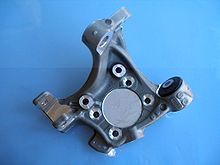Cobapress
Cobapress is a process for the production of components from aluminum . The process was patented by the French family company Saint Jean Industries .
Cobapress is a combination of casting and subsequent drop forging , hence the artificial name of the process: COuler (casting), BAsculer (ejecting), PRESSer (pressing, forging). The parts manufactured with Cobapress are used, for example, in the automotive industry for essential parts in the chassis . Cobapress is therefore positioned between forged and cast workpieces in terms of both price and material properties (with the exception of the modulus of elasticity). This also applies to the freedom of design in the construction of the parts.
Usually the easily castable alloy AlSi 7Mg0.3 is used. The achievable strength values lie between those of cast and forged parts: With this alloy, strength values of around 200 to 220 MPa yield point and 300 to 325 MPa tensile strength with an elongation at break of 8 to 10% are achieved. (For comparison: Other aluminum alloys are used in forging. The strength values that can be achieved by forging with AlSi1MgMn, which is often used in automotive engineering, are around 360 MPa yield strength and 380 MPa tensile strength with an elongation at break of over 10%. Casting alloys are used in conventional casting and thus strengths of around 200 MPa yield strength and 270 MPa tensile strength at around 6% elongation at break.) The modulus of elasticity that is important for many applications is around 68 GPa.
Description of the procedure
In the Cobapress method, first by means of molds - centrifugal casting an ingot cast. This blank is cleaned, burrs and sprue are removed.
Then a so-called homogenization (heating to a high temperature for several hours) is carried out.
This homogenized blank is then forged in a forging press; the resulting burrs must be removed again.
Finally, a heat treatment ( solution annealing , quenching and artificial aging ) is carried out in order to achieve the desired strength properties. Optionally, the parts can also be shot-peened at the end in order to increase the fatigue strength values .
Benefits of Cobapress
- Manufacture of difficult geometries that cannot be achieved by forging
- Lower price compared to forged parts
- Higher strength than cast parts
Disadvantages of Cobapress
- So far no use of high-strength, difficult-to-cast aluminum alloys
- Lower strength compared to pure forged parts
- Higher price compared to cast components
- Residual porosity present
- Alloy-related lower corrosion resistance compared to forged components
- z. B. Intergranular corrosion according to DIN EN ISO 11846: 2008-08; Corrosion of metals and alloys - Determination of the resistance of solution-annealed aluminum alloys to intergranular corrosion (ISO 11846: 1995; German version EN ISO 11846: 2008)
literature
- Bernd Heissing: Chassis manual: basics, driving dynamics, components, systems, mechatronics, perspectives. Vieweg + Teubner Verlag, 2007, ISBN 978-3834801050 , p. 299 ( limited preview in the Google book search).

